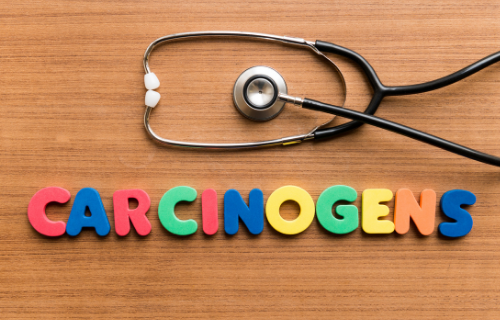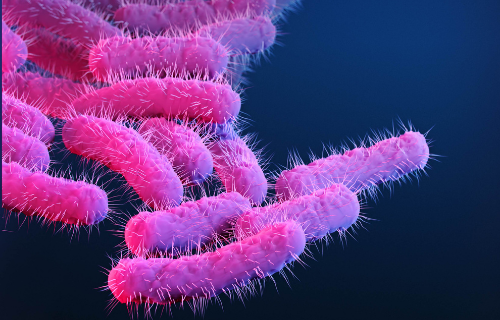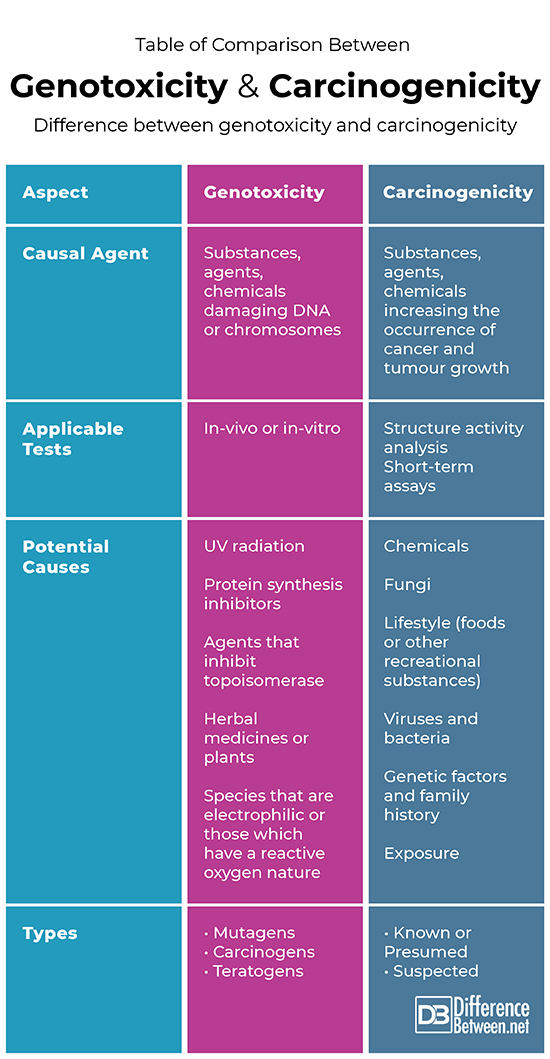Difference Between Genotoxicity and Carcinogenicity

Introduction
When it comes to alterations in the genetic materials of cells, genotoxicity and carcinogenicity are important conditions to be aware of!
Genotoxicity relates to direct or indirect damage to DNA structures or chromosomes, specifically caused by genotoxins (substances, agents or specific chemicals). Carcinogenicity relates to the ability of carcinogenic substances to cause premature growths and cancers.
Although often interlinked, each of these conditions have unique components, classifications and tests done to identify them.
This article will explore the differences between genotoxicity and carcinogenicity and digs deeper to differentiate their unique aspects.
Definition
Genotoxicity
Genotoxicity is defined as the damage done to DNA or chromosomes due to a genotoxin. Genotoxins are substances, agents or specific chemicals that are responsible for the damage done behind genotoxicity.
Genotoxins are classified by the damaging effects they have. These categories include:
- Agents causing mutation (mutagens)
- Agents causing cancer (carcinogens): those where genetic material is damaged in somatic cells and potentially result in cancer
- Agents causing birth defects (teratogens): those where genetic material is damaged in germ cells and potentially result in birth defects
Carcinogenicity
Carcinogenicity is defined as the ability of a carcinogen to cause cancer. A carcinogen is defined as a type of substance which has the capability to significantly increase the probability or occurrence of a tumour. This includes the ability to cause a tumour to occur more quickly than it would have.
When carcinogens are determined, they are placed into two categories. The first is “known (a) or presumed (b) human carcinogens” and the second is “suspected human carcinogens”.
- Known or Presumed Human Carcinogens: these refer to substances which have a known or probable potential to be carcinogenic in humans. When they are known, it is based off of actual evidence of the substance being a carcinogen in humans. When a substance is presumed to be carcinogenic in humans, it is based off of evidence gathered from animals.
- Suspected Human Carcinogens: these refer to substances or chemicals which do appear to be carcinogenic, due to existing evidence. However, the evidence that exists is not sufficient enough for the carcinogen to actually be classified as “known”.

Tests and Studies
Genotoxicity testing is either in-vitro or in-vivo. In-vitro tests include bacterial reverse mutation testing, cell gene mutation tests and chromosome aberration tests. In-vivo tests include comet assay tests, micronuclei tests or chromosome aberration tests. These tests are developed to detect agents that cause genetic damage either directly (directly alter DNA) or by mechanisms causing indirect damage (such as genetic alterations or the altering of proteins).
Carcinogenicity can be tested by looking at molecular components. This includes looking at genetic markers to determine how susceptible one is, analysing biological markers to assess exposure, looking at gene mutations and looking at cellular responses within DNA. Specialized tests are those such as a structure-activity analysis and short-term analysis (assays). There is also a specialized test for rodents (rats) to identify carcinogenicity among the species. This test is however not applicable to people!
Responsible Agents, Substances or Chemicals
Genotoxins include:
- UV radiation
- Protein synthesis inhibitors
- Agents that inhibit topoisomerase
- Herbal medicines or plants
- Species that are electrophilic or those which have a reactive oxygen nature
Carcinogens include chemicals such as asbestos, arsenic, exposure to beryllium, aflatoxin mixtures from fungi, and many, many more. Determining if a substance is carcinogenic or not is highly dependent on other factors too. These factors include genetic make-up, race, exposure time to a chemical or substance, etc. In other words, carcinogens are carcinogenic when they have certain effects and cause alterations in a variety of people. Other causes of carcinogenicity that are sometimes overlooked include lifestyle (types of foods and recreational substances), family history, as well as exposure to certain bacteria and viruses picked up through contact or from the surrounding environment.
Table of comparison between genotoxicity and carcinogenicity

Summary
Genotoxicity and carcinogenicity both involve action on genetic material. Where genotoxins are not necessarily cancerous (although they can be), carcinogens cause tumours and other premature growths.
Genotoxicity can be caused by various factors, from radiation to certain substances. Carcinogenicity also relate to various chemicals, but also largely depend on genetic make-up such as race, as well as exposure time.
Tests for genotoxicity can be performed in-vitro or in-vivo, whereas tests for carcinogenicity include structure-activity analysis and short-term assays.
Carcinogens can cause genotoxicity, meaning that certain carcinogens can change cell genetic material and end up causing cancer. However, that is not always the case! It is possible for carcinogens to simply cause benign growth too.
FAQ
What is meant by genotoxicity?
Genotoxicity refers to the damage done by genotoxins to DNA or chromosomes.
Genotoxins are classified by the damaging effects they have. These categories include:
- Agents causing mutation (mutagens)
- Agents causing cancer (carcinogens): those where genetic material is damaged in somatic cells and potentially result in cancer
- Agents causing birth defects (teratogens): those where genetic material is damaged in germ cells and potentially result in birth defects
Is a carcinogen a mutagen?
A mutagen is defined as substances or catalyzing agents which are responsible for genetic mutations. Carcinogens are also responsible for genetic mutations, and therefore can be mutagens too. However, they are not always mutagens, as they can be chemicals too.
Are carcinogens genotoxic?
Carcinogens can be genotoxic. When they are, then it means they are able to change genetic material of certain cells and directly alter them and produce cancer.
- Difference Between a Cochlear Implant and Normal Hearing - October 4, 2022
- Difference Between Obstructive and Restrictive Spirometry - September 11, 2022
- The Difference Between White Box and Black Box Testing - September 11, 2022
Search DifferenceBetween.net :
Leave a Response
References :
[0]Agency for Toxic Substances and Disease Registry. “Chemicals, Cancer, and You”. https://www.atsdr.cdc.gov/emes/public/docs/Chemicals,%20Cancer,%20and%20You%20FS.pdf
[1]Hayashi, Y. “Overview of genotoxic carcinogens and non-genotoxic carcinogens”. Experimental and Toxic Pathology, vol. 44, no. 8, 1992, pp: 465-471.
[2]Mohamed, S.A.K.S., Sabita, Upreti., Rajendra, S.V. & Raman, Dang. “Genotoxicity: Mechanisms, Testing Guidelines and Methods”. Global journal of Pharmacy and Pharmaceutical Science, vol. 1, no. 5, 2017, pp: 001-006.
[3]National Research Council (US). “Methods for Evaluating Potential Carcinogens and Anticarcinogens”. Carcinogens and Anticarcinogens in the Human Diet: A Comparison of Naturally Occurring and Synthetic Substances, 1996.
[4]Philips, David. H. & Arlt, Volker. M. “Genotoxicity: damage to DNA and its consequences”. Molecular, Clinical and Environmental Toxicology, vol. 1, 2009, pp:87-110.
[5]Srivastava, R., Mishr, N. & Singh, Uma. “Genotoxicity: mechanisms and its impact on human diseases”. Semantic Scholar, 2016. https://www.semanticscholar.org/paper/Genotoxicity-%3A-mechanisms-and-its-impact-on-human-Srivastava-Mishra/f016576f8810c7854452fb416284f0d9bcbc7992
